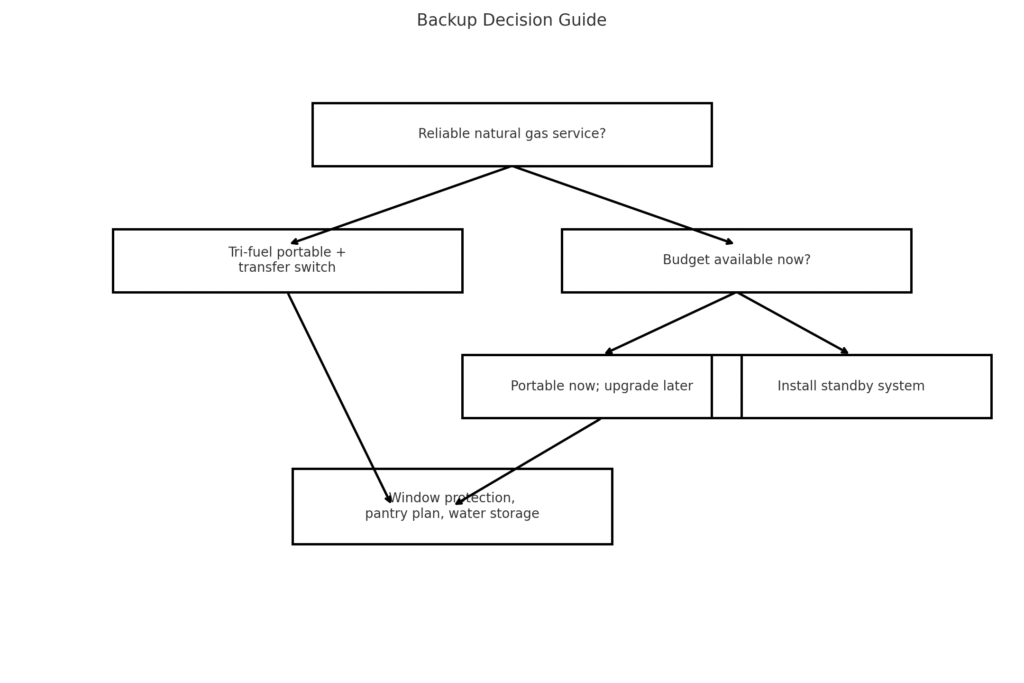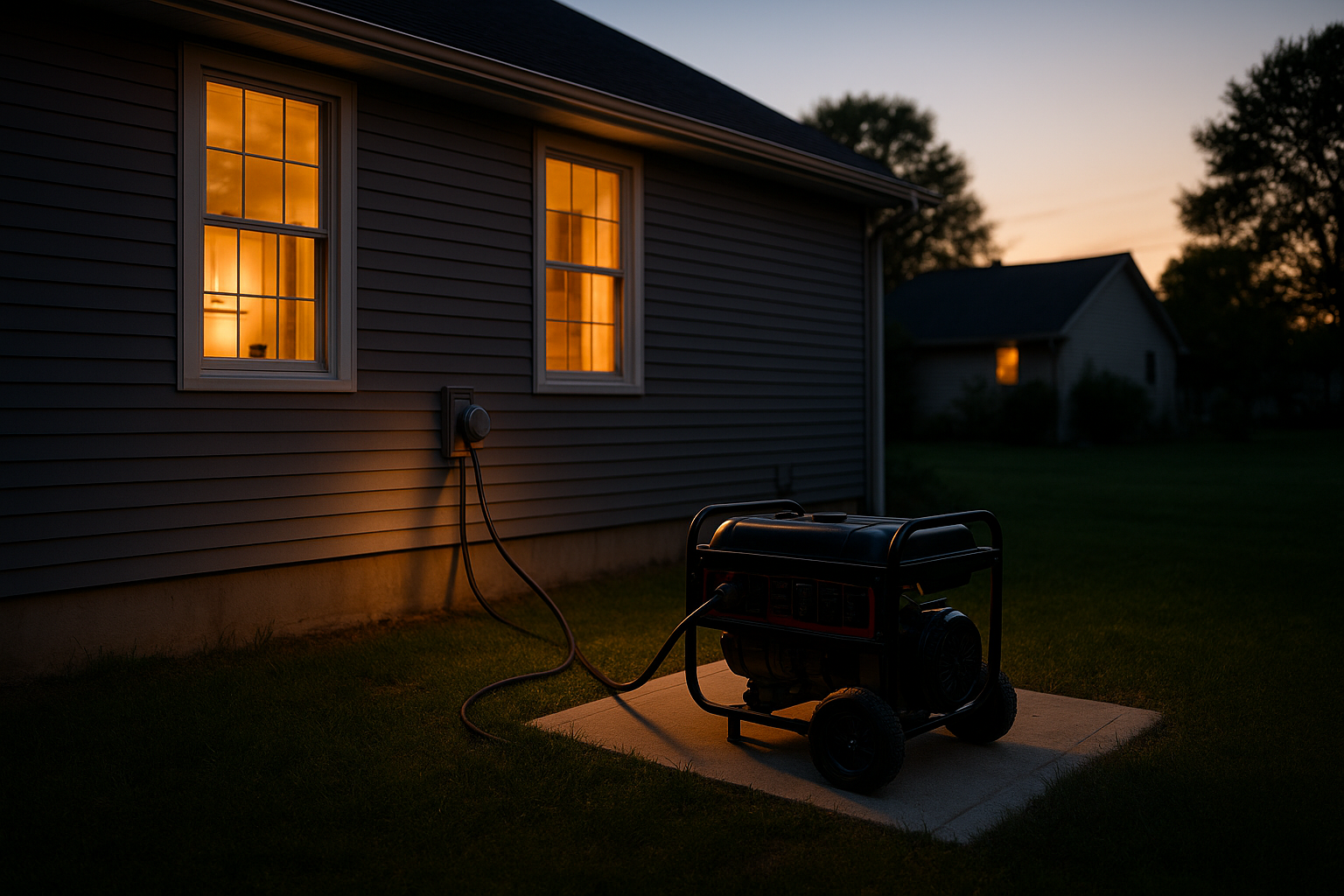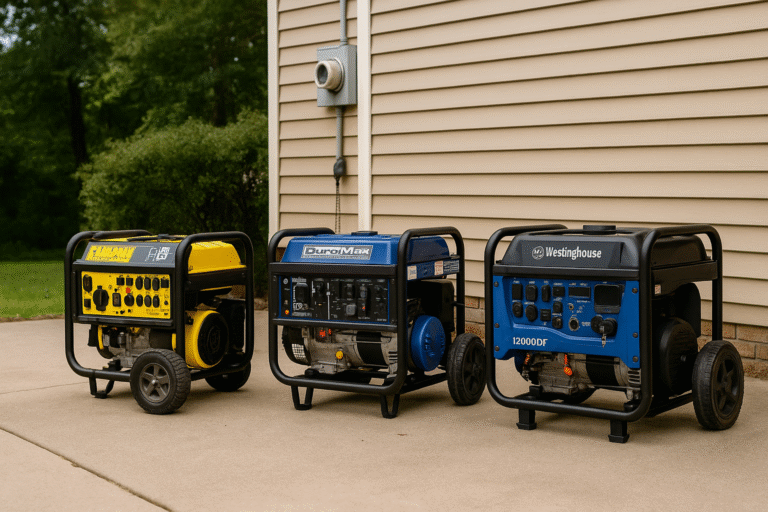Standby vs Tri-Fuel Portable Generator: The Smarter First Investment for Home Backup
Home backup is a sequence of decisions, not a single purchase. The choice many households face is whether to begin with a tri-fuel portable generator or save toward a fixed standby unit. Both approaches can work. One path gets most families protected sooner and keeps options open for the future.
What a standby generator provides
A quality standby unit restores power automatically within seconds. The transfer is smooth, circuits are predefined, and runtime can be extended on natural gas when utility service is available. Maintenance is predictable and the operating experience is simple. The price reflects that. The install requires a pad, gas plumbing, electrical labor, permits, and coordination. For some homes, the budget and timeline put this option out of reach for the next season.
What a tri-fuel portable provides
A tri-fuel portable generator covers the same essential loads when used with a transfer switch. It trades automatic transfer for manual operation, but it brings flexibility that matters during regional events. It can run on gasoline for maximum surge performance, on propane for clean storage, or on natural gas for long duration if the service is up. It can be staged on a pad before the storm, run in short windows to cool a refrigerator, draw water from a well, and power a small lighting branch. It also costs a fraction of a full standby system. Most households can deploy this plan now rather than later.
Fuel logistics and runtime
Fuel planning is the difference between a smooth outage and a scramble. Gasoline offers the best surge performance for compressor starts. Propane stores cleanly and is easy to move in cylinders. Natural gas provides long duration without handling fuel at all. A tri-fuel portable moves across these layers without conversion kits. That is valuable when a hurricane disrupts deliveries or crowds fuel stations. A standby unit enjoys the same natural gas advantage, but it depends entirely on that single supply.
Safety, sound, and placement
Any combustion engine must live outside with an exhaust path that faces away from openings. Standby units are fixed and typically sited with clearances that protect the household. Portables can meet the same standard when a small pad is prepared in advance and the run sequence is written down. Sound profiles are similar across 12 kW class portables. The practical way to manage sound is to batch heavy loads into short sessions, close doors and windows, and shut down when tasks are complete.
Cost of ownership across time
The cost curve favors the portable route for most families in the first three years. The upfront spend covers the generator, a transfer solution, and basic accessories. The plan can be upgraded later with a better pad, a gas quick-connect, or an expanded essential circuits list. A standby system concentrates the expense on day one. For households with other storm hardening to pay for, beginning with a tri-fuel portable leaves room for window protection, pantry planning, water storage, and communications gear.
Reliability in real storms
A plan is reliable when it matches the realities of a region. In hurricane zones, outages vary in length and fuel availability changes by the day. A tri-fuel portable meets this variability head-on. It uses gasoline early for demanding starts, propane during distributor delays, and natural gas when the utility restores service before the electrical grid. A standby system remains the gold standard for convenience; it is not always the most resilient choice during multi-day, supply-constrained events.
When a standby makes sense
Some homes should skip straight to standby. Critical medical equipment, extended temperature control needs, or work that cannot tolerate manual transfer justify the expense. If the budget supports it and the local gas utility is historically stable, a standby unit is a sound investment. Even then, a small portable remains useful for targeted circuits, field work, or neighbors who need help before a storm.
A clear first step for most households
For families building resilience on a realistic budget, a tri-fuel portable with a proper transfer switch is the best first move. It covers essential circuits, reduces food loss, supports water access, and keeps communications online. It scales over time toward a standby system if desired. It also leaves budget for the other work that matters: window protection, pantry planning, water storage, and a communications checklist.
Decision pressure can be reduced to a few simple questions. The quick flow below helps households sort their situation and pick a path that fits.

Conclusion
Resilience improves fastest when households make a strong first move. A tri-fuel portable generator paired with a safe transfer solution delivers essential power immediately and adapts to messy fuel realities after a storm. Standby systems remain an excellent destination for convenience. The portable route gets most families protected now and preserves the option to install a standby system later.o install a standby system later.









